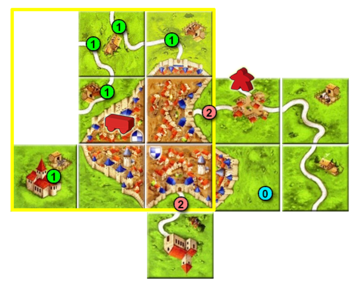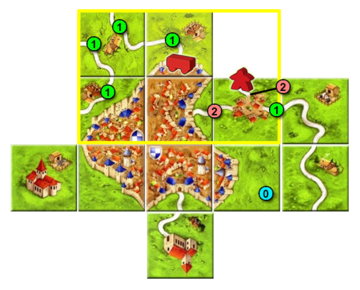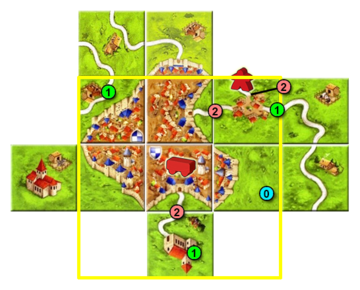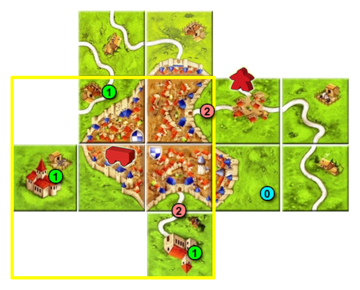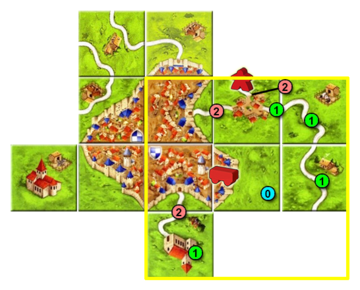Modifications des règles de déplacement du charriot

|
Introduction
Les règles régissant le déplacement du chariot ont changé entre les éditions. Ces changements affectent la façon dont le chariot se déplace après l’évaluation et son rayon d’action.
Les règles des deux éditions sont disponibles ici :
- Édition classique : Les règles du chariot pour la première édition
- Nouvelle édition : Les règles du chariot pour la nouvelle édition
The following sections illustrate these differences with various examples. [1]
Édition classique (C1)
If a wagon is placed in a city completed and scored, the wagon can only move to a road, if this road (uncompleted and unoccupied) is directly adjacent to this city (connected to the city walls through a gate). Since a field (farm) is also a feature, there must be no field (farm) between the road and the city. It does not matter where the wagon is placed within the completed and scored feature (e.g. city) before it moves. Features sharing a surface like an adjacent abbey or a monastery (cloister) within a city can also be considered as a valid destination for the wagon.
Moving the wagon depends entirely on feature adjacency, not on the initial position of the wagon within the feature completed and scored. Likewise, the wagon can move to any tile of the adjacent feature (the number of tiles the wagon moves is irrelevant).
Exemple 1. Déplacement depuis une ville complétée
After the city is completed and scored, the wagon moves to an adjacent feature which has to be incomplete and unoccupied.
The city is completed by the surrounding walls and the abbey. The city is adjacent to the several fields (farms), an incomplete road, a short road, and an incomplete abbey. Additionally, there is also an incomplete monastery (cloister) within the city.
The wagon can move move to:
- The incomplete road (any of its tiles)
- The incomplete abbey
- The incomplete monastery (cloister) within the city
The wagon cannot move to:
- Any field (farm) adjacent to the city
- Any road not connected to the city through a gate
- The short road connected to the city or any roads connected to it at the junction
- The incomplete road connected to the abbey, since it is not connected directly to the city
- The monastery (cloister) with the completed road connected to the abbey
- The incomplete city connected through short roads and a junction
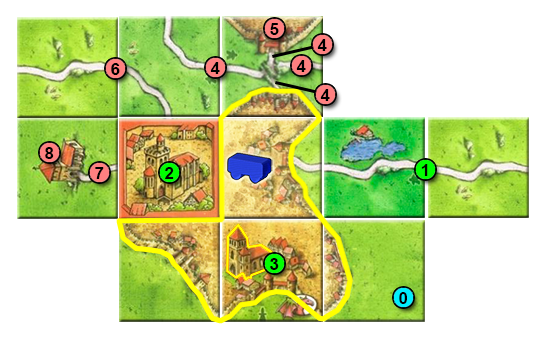
- 0 Tile just placed.
- 1 The wagon can move to this road.
- 2 The wagon can move to this abbey.
- 3 The wagon can move to the monastery (cloister) within the city.
- 4 The wagon cannot move to the short road ending at the completed city or to any road connected to it through the junction.
- 5 The wagon cannot connect to this city because it is connected through short roads and a junction to the completed city.
- 6 The wagon cannot move to this uncompleted road because it is connected to the abbey, not to the completed city.
- 7 The wagon cannot move to this road because it is completed and connected to the abbey, not to the completed city.
- 8 The wagon cannot move to this monastery (cloister) because it is directly connected to the completed city; it is connected to a completed road leading to the abbey.
Exemple 2. Déplacement depuis une ville complétée
After the city is completed and scored, the wagon moves to an adjacent feature which has to be incomplete and unoccupied.
The city is completed by the surrounding walls. The city is adjacent to the several fields (farms) and 3 roads. Two roads are completed, so the wagon can only move to the incomplete road at the top.
The tile where the wagon is placed in the city does not affect the possible options. The result is always the same: an adjacent uncompleted unoccupied feature to the city.
Likewise, if the wagon is moved to the incomplete road, it can be placed on any of its tiles.
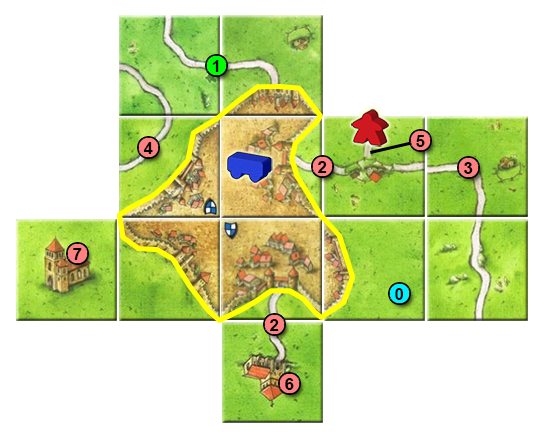
- 0 Tile just placed.
- 1 The wagon can move to this road. It can be placed on any of its tiles.
- 2 These roads are connected to the city but they are completed.
- 3 This road does not border directly at the city wall because it starts at the junction.
- 4 This road does not border directly at the city wall because there is a field (farm) between this road and the completed city.
- 5 This road does not border directly at the city wall because it starts at the junction and it is occupied.
- 6 This monastery (cloister) is not directly adjacent to the completed city because there is a completed road between the monastery (cloister) and the completed city.
- 7 This monastery (cloister) is not directly adjacent to the completed city because it is surrounded by a field (farm).
Exemple 3. Déplacement depuis une route complétée
After the road is completed and scored, the wagon moves to an adjacent feature which has to be incomplete and unoccupied.
The wagon can move to an adjacent feature on any of the road's ends. The number of tiles the wagon moves is irrelevant. It is only important that the feature is directly adjacent to the completed road.
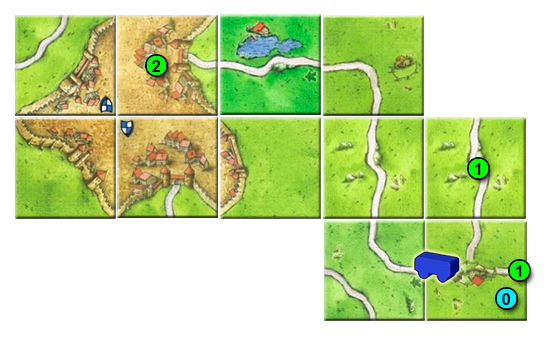
- 0 Tile just placed.
- 1 The wagon can move to any tile of these directly adjacent roads, because they are uncompleted and unoccupied.
- 2 The wagon can move to any of the tiles in the city because it is directly adjacent to the completed road (the city closes its left end), and it is uncompleted and unoccupied.
Nouvelle édition (C2)
The wagon can move to any feature except fields. However, the new edition allows the wagon to cross a field to reach an uncompleted unoccupied feature on the same tile where the wagon is placed or on an adjacent tile.
Moving the wagon depends on the location of the wagon within the feature completed and scored. The target feature can be on the same tile or on an adjacent one. Therefore, the wagon can move one tile away at most.
Exemple 1. Déplacement depuis une ville complétée
After the city is completed and scored, the wagon moves to an adjacent feature which has to be incomplete and unoccupied.
In this case, "adjacent" means a feature on the same tile as the wagon or on a tile orthogonally or diagonally adjacent to it.
This means, the wagon action range is limited because it can only move to the same tile or to any of the tiles on the 8 spaces surrounding it.
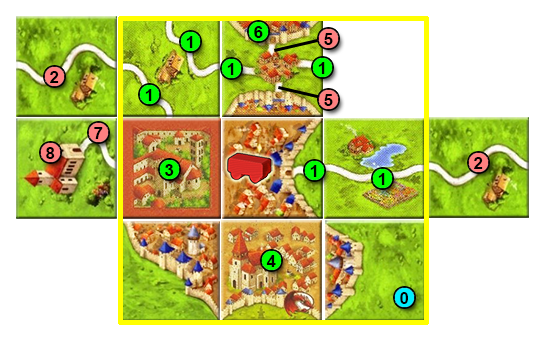
- 0 Tile just placed.
- 1 The wagon can move to any of these road segments on tiles within range because they belong to uncompleted unoccupied features.
- 2 The wagon cannot move to these road segments on tiles out of range even if they belong to uncompleted unoccupied features.
- 3 The wagon can move to this uncompleted unoccupied abbey because it is within range.
- 4 The wagon can move to the uncompleted unoccupied monastery within the city because it is within range.
- 5 The wagon cannot move to any of these short roads.
- 6 The wagon can move to this uncompleted unoccupied city segment within range.
- 7 The wagon cannot move to this road because it is completed and out of range.
- 8 The wagon cannot move to this monastery because it is out of range even if it is uncompleted and unoccupied.
Exemple 2. Déplacement depuis une ville complétée
After the city is completed and scored, the wagon moves to an adjacent feature which has to be incomplete and unoccupied.
In this case, "adjacent" means a feature on the same tile as the wagon or on a tile orthogonally or diagonally adjacent to it.
This means, the wagon action range is limited because it can only move to the same tile or to any of the tiles on the 8 spaces surrounding it.
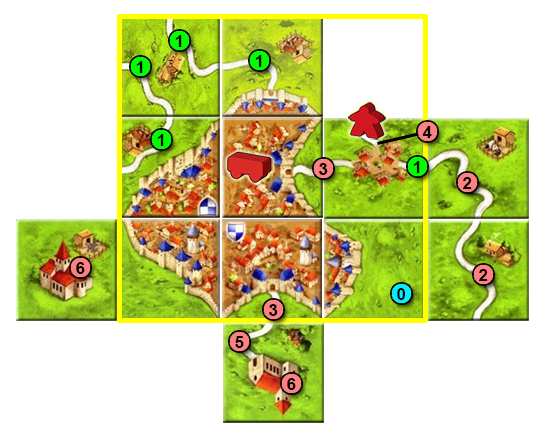
- 0 Tile just placed.
- 1 The wagon can move to any of these road segments on tiles within range because they belong to uncompleted unoccupied roads.
- 2 The wagon cannot move to these road segments on tiles out of range even if they belong to uncompleted unoccupied roads.
- 3 The wagon cannot move to this road segment on a tile within range because the feature is completed.
- 4 The wagon cannot move to this road segment on a tile within range because the feature is uncompleted but occupied.
- 5 The wagon cannot move to this road segment because it is out of range and belongs to a completed feature.
- 6 The wagon cannot move to any of these monasteries because they are out of range although uncompleted and unoccupied.
Depending on the position of the wagon in the city, the action range changes, as shown below.
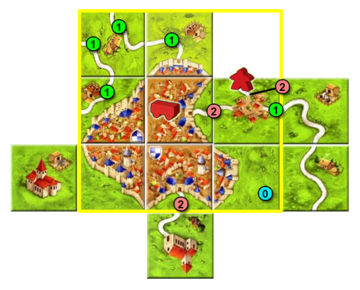
- 0 Tile just placed.
- 1 The wagon can move to any of these road segments on tiles within range because they belong to uncompleted unoccupied features.
- 2 The wagon cannot move to road segments within range on these roads because they belong to completed or occupied features.
Exemple 3. Déplacement depuis une route complétée
After the road is completed and scored, the wagon moves to an adjacent feature which has to be incomplete and unoccupied.
In this case, "adjacent" means a feature on the same tile as the wagon or on a tile orthogonally or diagonally adjacent to it.
This means, the wagon action range is limited because it can only move to the same tile or to any of the tiles on the 8 spaces surrounding it.
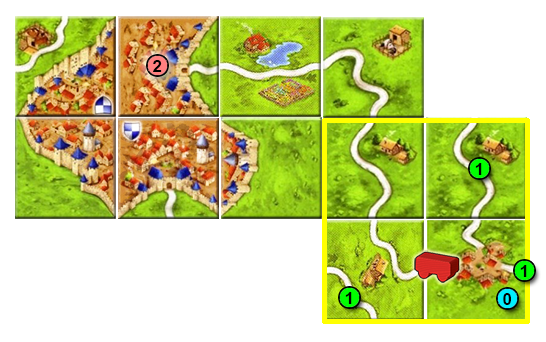
- 0 Tile just placed.
- 1 The wagon can move to any of these tiles within range because they belong to uncompleted unoccupied roads; two of them are connected to the same crossroads closing the road with the wagon and the other is on an orthogonal tile separated by a field.
- 2 The wagon cannot move to this uncompleted unoccupied city closing the road just completed because it is out of range.
Notes
Pour les licences et les explications des icônes, veuillez visiter la page des icônes.
- ↑
 These examples are based on the clarifications provided by Kettlefish in the following Carcassonne Forum posts, expanding the first example to cover both editions with the inclusion of additional cases as well (abbeys and short roads):
These examples are based on the clarifications provided by Kettlefish in the following Carcassonne Forum posts, expanding the first example to cover both editions with the inclusion of additional cases as well (abbeys and short roads):
- Classic edition examples: https://www.carcassonne-forum.de/viewtopic.php?f=292&t=3662#p46509
- New edition examples: https://www.carcassonne-forum.de/viewtopic.php?f=292&t=3662#p46513
